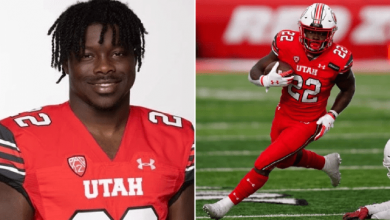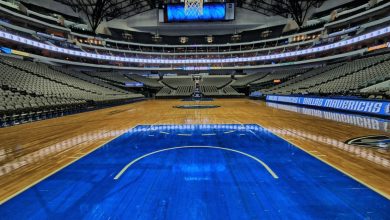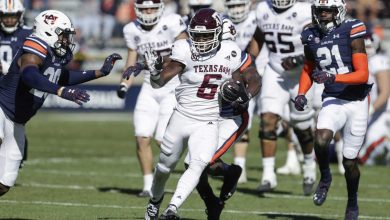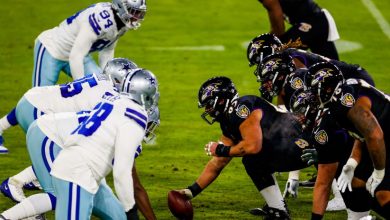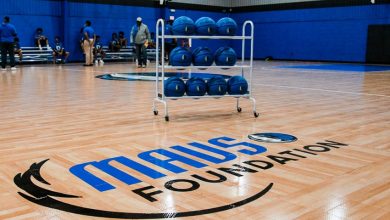The Top 5 NFL Defensive Linemen Produced by TCU
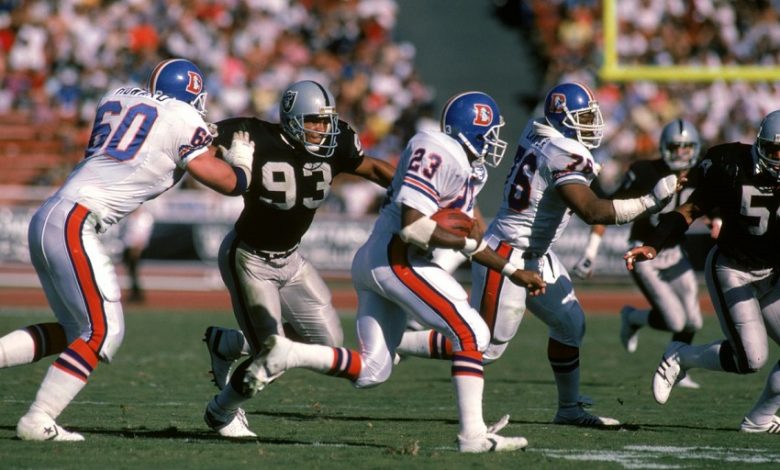
This year won’t soon be forgotten for a variety of reasons, and that rings true for TCU Football. Gary Patterson’s Horned Frogs saw two players selected in the first round for only the second time in program history and the first time since 1939.Wide receiver Jalen Reagor was picked 21st overall by the Eagles and cornerback Jeff Gladney picked 31st overall by the Vikings. In 1939, TCU’s head coach was the legendary Dutch Meyer, a two-time national champion who is known today in Fort Worth for being the namesake of an excellent burger joint on South University Drive.
Rounds two and three made more history. TCU had two more players come off the board: defensive tackle Ross Blacklock, picked 40th overall by the Houston Texans and offensive tackle Lucas Niang was picked 96th overall by the Kansas City Chiefs. The 2020 Draft became the first time TCU saw four players drafted in the top three rounds.
Given that history, it only makes sense to look back at the best NFL players the Horned Frogs have produced to this point at each position.
After taking a look at Quarterbacks, Wide Receivers, Running Backs and Offensive Tackles, the focus turns to Defensive Linemen. The Horned Frogs defensive line position includes one of the best players to ever play the game, the Raiders career sacks leader, and one of the best pass-rushers of the 2000’s. Not bad for a small school in Fort Worth, Texas.
1. Bob Lilly
Resume:
– 1980 Pro Football Hall of Fame Inductee
– 11-time Pro Bowl selection and 7-time 1st-Team All-Pro selection
– Super Bowl VI Champion
– Drafted 13th overall in the 1st round by the Cowboys in the 1961 NFL Draft
– Played 14 seasons with the Cowboys (1961-1974)
Career Numbers:
– Played and started in 196 consecutive regular season games
– 18 fumbles recovered and 3 fumble return touchdowns
– 1 interception — which was returned for a touchdown
Bob Lilly is one of the best football players in the 150-year history of college football and the 100-year history of the NFL. During his three years as a Horned Frog, TCU won two Southwest Conference championships and earned bowl game appearances in the Cotton Bowl against Air Force and the Bluebonnet Bowl against Clemson. Lilly was named a consensus 1st Team All-American during the 1960 season, his last as a collegiate football player.
The Cowboys made him their first draft choice, selecting Lilly 13th overall in the 1961 NFL Draft. In the 14 NFL seasons that encompassed Lilly’s career, he NEVER missed a game. I repeat, Lilly played and started in 196 consecutive NFL regular seasons. Playing in the 1960’s and 1970’s without some of the more advanced medical treatments, sleep and dietary research, and painkillers available now, that’s remarkable.
However, Lilly didn’t simply show up, he dominated, earning seven first-team All-Pro selections, tied for the third-most All-Pro selections in NFL history among defensive linemen. Only Bruce Smith and Reggie White, the two Hall of Famers with the most sacks in league history, have more. Lilly’s 11 Pro Bowl selections are also tied for the third most among defensive linemen behind only two other Hall of Famers Merlin Olsen and Reggie White. Unfortunately for Lilly, the NFL didn’t start tracking the sack as an official statistic until 1982, but he still earned his well-earned awards by becoming the first Cowboys player inducted into the team’s Ring of Honor and the Pro Football Hall of Fame. Mr. Cowboy was also a member of the NFL 100 All-Time Teamas his career stacks up even today as one of the best to ever slow down a ground game and pressure the opposing quarterback.
2. Greg Townsend
Resume:
– 2-time Pro Bowl selection
– Super Bowl XVIII Champion with the Raiders
– Drafted 110th overall in the 4th round by the Raiders in the 1983 NFL Draft
– Played 13 seasons with the Raiders (1983-1993, 1997) and Eagles (1994)
Career Numbers:
– Started 102 of 190 career games
– 109.5 career sacks (107.5 with the Raiders, most in team history)
Greg Townsend had the misfortune of playing for the Horned Frogs in the final years of F.A. Dry’s head coaching tenure as TCU went a combined 5-15-2 from 1981-192. With the lack of a reason to pay attention to TCU at the beginning of the 80’s, Townsend slid to the 4th round where he was drafted by Al Davis’ Bad Boy Raiders in 1983. His rookie campaign couldn’t have been much better even if Townsend had the ability to script it out beforehand.
He had the second-most sacks (10.5) among all rookies in 1983 (only Colts linebacker Vernon Maxwell had more with 11.0), and the Raiders won Super Bowl XVIII vs Washington for their second title in four seasons. Townsend had one of the Raiders’ six sacks of quarterback Joe Theismann.
Another intriguing note about Townsend’s productive first season is that he didn’t start in a single game! In fact, Townsend didn’t start a game until his fourth season in 1986. His four-season peak naturally occurred from 1988-1991 (his age 27-30 year-old seasons). Townsend totaled double-digit sacks in each season (11.5, 10.5, 12.5 & 13.0), making him and Hall of Famer Reggie White the only two players in the NFL with four seasons in that span. The last years of that run (1990 & 1991) resulted in the only Pro Bowl selections of his career as he racked up the two-highest sacks totals of his career (12.5 & 13.0). Those 25.5 sacks from 1990 to 1991 were the fourth-most sacks in the NFL in that time span. Only Saints linebacker Pat Swilling (1991 Defensive Player of the Year) and two Hall of Famers (Reggie White & Derrick Thomas) had more. Greg Townsend’s productivity and longevity make him the second-best pass rusher to represent TCU at the highest level.
3. Aaron Schobel
Resume:
– 2-time Pro Bowl selection
– Drafted 46th overall in the 2nd round by the Bills in the 2001 NFL Draft
– Played 9 seasons with the Bills (2001-2009)
Career Numbers:
– Started 128 of 133 career games
– 78.0 sacks (8th-most sacks in NFL during 9-year career)
Aaron Schobel is a TCU Hall of Fame player who had the misfortune of a solid NFL career being wasted on some terrible teams . At TCU, he was nothing short of spectacular while playing for then-TCU defensive coordinator Gary Patterson. Schobel totaled 31.0 career sacks (most in program history) as he started 46 straight games. That type of productivity and durability led this three-time All-Western Athletic Conference selection to be the sixth defensive end off the board in the 2001 NFL Draft.
Schobel’s production transferred to the NFL as his 78.0 career sacks were the 8th-most in the entire league during his 9-year career. He had four double-digit sack seasons from 2001-2009, tied for the sixth-most in the NFL in that span. The only players with more such seasons were a who’s-who of pass-rushers during the 2000’s: Dwight Freeney, Julius Peppers, John Abraham, Simeon Rice, and Jason Taylor. His peak was in the 2005 and 2006 seasons when he recorded 26.0 sacks, the third-most in the NFL over those two seasons. The only players with more, Raiders defensive end Derrick Burgess and Chargers linebacker Shawne Merriman, had just one more sack, 27.0, than Schobel.
The only Buffalo Bill with more sacks than Schobel in team history: the NFL’s career leader, Hall of Famer Bruce Smith. Schobel led three top-ten scoring defenses during his time in Buffalo (2003, 2004, and 2006), but the Bills were limited by an offense that averaged 18.7 points per game in his nine seasons, the 5th-worst in the NFL in that time. That futile scoring output resulted in the Bills being 28 games under .500, 58-86, from 2001 to 2009, the 5th-worst record in the NFL. While he never tasted the playoffs, Aaron Schobel was one of the best pass-rushers to play in the 2000’s.
4. Joe Robb
Resume:
– 1967 Pro Bowl selection
– 1960 NFL Champion with Eagles
– Drafted 164th overall in the 14th round by the Bears in the 1959 NFL Draft
– Played 13 seasons with the Eagles (1959-1960) , Cardinals (1961-1967) & Lions (1968-1971)
Career Numbers:
– Started 134 of 159 career games
– 1 INT, 1 forced fumble & 16 fumbles recovered
Joe Robb had a solid, but not spectacular, NFL career. After three seasons at TCU (1956-1958) where he was a part of two Cotton Bowl teams (won in 1956 vs RB Jim Brown and Syracuse; and tied in 1959 vs Air Force), Robb was drafted in the 14th round (the equivalent of 2 drafts today) in the 1959 NFL Draft by the Bears.
Being a 14th pick, the odds were stacked against him making the Bears roster out of training camp. However, he was able to latch on with the Eagles where he started 18 of a possible 24 games, not too shabby for the former 146th overall pick. Robb played a role for a historic Eagles team in 1960: Robb was a starter in the NFL Championship Game, a game the Eagles won 17-13, making them the only team to defeat Vince Lombardi’s Packers in the playoffs.
Brutal is the business of football as Robb was traded to the Cardinals in the following offseason. Robb would play out his prime over the next seven seasons with the club, earning his only Pro Bowl selection following the 1966 season. Robb began his career with the entire league passing on him 13 times over and ended it 14 seasons later. That longevity out of someone picked that low is unheard of, especially when factoring that he was a starter for a championship team. Joe Robb kept his eyes up and kept climbing, making him one of TCU’s most resilient professional football players.
5. Jerry Hughes
Resume:
– Drafted 31st overall in the 1st round by the Colts in the 2010 NFL Draft
– Currently playing his 11th NFL season & 8th with the Bills (2013-2020) after 3 with the Colts (2010-2012)
Career Numbers:
– Started 105 of 154 career games
– 51.5 sacks (46.5 with Bills)
Someone who is drafted in the first round in any professional sport wouldn’t usually have their career associated with perseverance, but it’s accurate for Jerry Hughes. After consecutive seasons as a consensus All-American in 2008 and 2009 in Fort Worth, he became the second-to-last pick of the 1st round in 2010 by Peyton Manning’s Colts, a team coming off a narrow Super Bowl defeat against the Saints. Hughes seemed to find an ideal landing spot with the Colts. He would have the opportunity to learn the pro game from defensive ends Dwight Freeney and Robert Mathis, two of the top 20 sack artists the NFL has ever seen.
However, those two bookends blocked Hughes’ path to playtime as he started just seven of the forty games he played in Indianapolis, recording only five sacks. A change of scenery was needed for both parties as Hughes was flipped to Buffalo prior to the 2013 season for linebacker Kelvin Sheppard, a 3rd-round pick in 2011. Some people might have become frustrated with a trade to Buffalo (Antonio Brown begged not to be traded there in 2019), but Hughes embraced the move and recorded 10 sacks in each of his first two seasons with the team in 2013 and 2014. Those remain the two best seasons of his career, which resulted in a 5-year, $45 million contract extension in 2015. Hughes has continued to be recognized for his steady play and leadership as the team re-signed him to a 2-year, $23 million contract extension in 2019.
This season, the longest-tenured Bills player was named a team captain for the first time after the Bills reached the playoffs for the second time in three seasons under head coach Sean McDermott. Buffalo quarterback Josh Allen became the first Bills passer with more than 400 (417) pass yards, four passing touchdowns and no interceptions in a game this past Sunday in a 31-28 win against the Dolphins. Hughes may be able to stick around long enough to be a part of the first Buffalo ball club to win a playoff game since 1995. With the career he’s had, Hughes is someone Gary Patterson will always bring up as the standard of what a defensive lineman from his TCU program can achieve.

